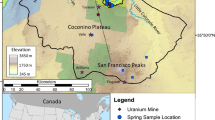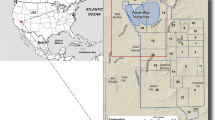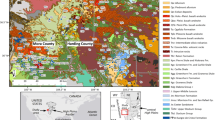Abstract
Groundwater systems in the San Luis Valley, Colorado, USA have been re-evaluated by an analysis of solute and isotopic data. Existing stream, spring, and groundwater samples have been augmented with 154 solute and isotopic samples. Based on geochemical stratification, three groundwater regimes have been identified within 1,200 m of the surface: unconfined, upper active confined, and lower active confined with maximum TDS concentrations of 35,000, 3,500 and 600 mg/L, respectively. The elevated TDS of northern valley unconfined and upper active confined systems result from mineral dissolution, ion exchange and methanogenesis of organic and evaporate lake sediments deposited in an ancient lake, herein designated as Lake Sipapu. Chemical evolutions along flow paths were modeled with NETPATH. Groundwater ages, and δ13C, δ2H and δ18O compositions and distributions, suggest that mountain front recharge is the principle recharge mechanism for the upper and lower confined aquifers with travel times in the northern valley of more than 20,000 and 30,000 14C years, respectively. Southern valley confined aquifer travel times are 5,000 14C years or less. The unconfined aquifer contains appreciable modern recharge water and the contribution of confined aquifer water to the unconfined aquifer does not exceed 20%.
Reśumé
Les systèmes hydrogéologiques de la Vallée de San Luis, au Colorado, USA, ont été ré-évalués par une analyse de données isotopiques et de solutés. Les données existantes des rivières, des sources et des eaux souterraines ont été complétées par 154 échantillons. Sur base de la stratification géochimique, trois régimes hydrogéologiques ont été définis de la surface jusqu’à 1200 mètres de profondeur : systèmes libres, systèmes captifs proches de la surface, et systèmes captifs profonds, avec des charges minérales dissoutes totales (TDS) respectives de 35,000, 35,000 et 600 mg/L. Les charges minérales élevées des deux systèmes les moins profonds résultent de la dissolution minérale, des échanges ioniques et de la méthanogénèse des dépôts sédimentaires organiques ou évaporitiques de l’ancien lac Sipapu. Les évolutions géochimiques le long des lignes d’écoulement ont été modélisées avec NETPATH. Les âges des eaux souterraines, et les compositions et distributions en δ13C, δ2H et δ18O, suggèrent que le front des montagnes est la principale origine de la recharge pour les aquifères supérieurs et inférieurs, avec des temps de séjours dans la partie Nord, respectivement de plus de 20,000 et 30,000 années 14C. Dans la partie Sud de la vallée, les temps de séjours sont de ou inférieurs à 5,000 années 14C. L’aquifère captif contient une part appréciable d’eaux modernes, et la contribution de l’aquifère captif à l’aquifère non-captif n’excède pas 20%.
Resumen
Se han evaluado de nuevo los sistemas de agua subterránea en el Valle de San Luis, Colorado, EUA, mediante un análisis de datos isotópicos y solutos. Las muestras existentes de agua subterránea, manantiales y arroyos se han incrementado con 154 muestras adicionales para análisis de isótopos y solutos. Basado en estratificación geoquímica se han identificado tres ambientes de agua subterránea en los primeros 1,200 m del subsuelo: no confinado, confinado activo superior, y confinado activo inferior con concentraciones máximas de SDT 35,000, 3,500 y 600 mg/L respectivamente. Los elevados SDT de los sistemas activo superior y no confinado del norte del valle se deben a disolución mineral, intercambio iónico, y metanogénesis de sedimentos lacustres evaporíticos y orgánicos depositados en un lago antiguo que se denomina en este artículo como Lago Sipapu. Se elaboraron modelos de evolución química a lo largo de las trayectorias de flujo con NETPATH. Las edades del agua subterránea y las composiciones y distribuciones de δ13C, δ2H y δ18O sugieren que el principal mecanismo de recarga lo constituye la recarga de los frentes montañosos para los acuíferos confinados inferior y superior con tiempos de viaje en el valle norte de más de 20,000 y 30,000 años14C, respectivamente. Los tiempos de viaje del acuífero confinado del valle sur son 5,000 años14C o menos. Los acuíferos no confinados contienen agua de recarga moderna en cantidades considerables y la contribución de agua confinada al acuífero no confinado no excede 20%.















Similar content being viewed by others
References
AWDI (1986) Preliminary geohydrologic investigation of the Baca land grant. Report, American Water Development Inc., Cleveland, OH, p 31
Burroughs RL (1981) Summary of the geology of the San Luis Basin, Colorado-New Mexico with emphasis on the geothermal potential for the Monte Vista graben. Colo Geol Surv Spec Publ 17:30
Clark ID, Fritz P (1997) Environmental isotopes in hydrogeology. CRC Press, Bacon Raton, FL, p 352
Craig H (1961) Isotopic variations in meteoric waters. Science 133:1702–1703
Dansgaard W (1964) Stable isotopes in precipitation. Tellus 16:436–467
Delmotte M, Masson V, Jouzel J, Morgan V (2000) A seasonal deuterium excess signal at Law Dome, coastal eastern Antarctica: a southern ocean signature. J Geophys Res 105(D6):7187–7197
Edmunds W, Wright E (1979) Groundwater recharge and paleoclimate in the Sirte and Kufra basins, Libya. J Hydrol 40:215–241
Emery PA (1970) Electric analog model evaluation of water-salvage plan, San Luis Valley, south-central Colorado. Colo Water Conserv Board Ground-Water Ser Circ 14:11
Emery PA, Boettcher AJ, Snipes RJ, McIntyre HJ Jr (1971) Hydrology of the San Luis Valley, south-central Colorado. US Geological Survey Hydrologic Atlas HA-0381, US Geological Survey, Reston, VA
Emery PA, Snipes RJ, Dumeyer JM (1972) Hydrologic data for the San Luis Valley, Colorado. Colo Water Conserv Board Basic-Data Release 22:146
Emery PA, Snipes RJ, Dumeyer JM, Klein JM (1973) Water in the San Luis Valley, south-central Colorado. Colorado Water Conserv Board Water Resour Circ 18:26
Epstein S, Mayeda TK (1953) Variations in the 18O/16O ratio in natural water. Geochim Cosmochim Acta 4:213–224
Fontes JCh (1983) Dating of groundwater in guidebook on nuclear techniques in hydrology, 1983 ed. IAEA Tech Rep Ser 91:285–317
Fontes JCh, Garnier JM (1979) Determination of the initial 14C activity of the total dissolved carbon: a review of existing models and a new approach. Water Resour Res 15(2):399–413
Fritz P, Reardon EJ, Barker J, Barown RM, Cherry JA, Killey RWD, McNaughton D (1978) The carbon isotope geochemistry of a small groundwater system in northeastern Ontario. Water Resour Res 14(6):1059–1067
Gat J, Daansgard W (1972) Stable isotope survey of fresh water occurrences in Israel and the Northern Jordan Rift Valley. J Hydrol 16:177–212
Gehre M, Hoefling R, Kowski P (1996) Sample preparation device for quantitative hydrogen isotope analysis using chromium metal. Anal Chem 68:4414–4417
Genty D, Plagnes V, Causse C, Cattani O, Stievanard M, Falourd S, Blamart D, Ouahdi R, Van-Exter S (2002) Fossil water in large stalagmite voids as a tool for paleoprecipitation stable isotope composition reconstitution and paleotemperature calculation. Chem Geol 184:83–95
Glanzman RK (1972) Fluoride in the confined ground water of the San Luis Valley, Colorado. MSc Thesis, Colorado School of Mines, Golden, CO, p 93
Glanzman RK (1979) Hydrogeochemistry of the closed basin, San Luis Valley, Colorado. In: Water in the valley: a 1989 perspective of water supplies, issues and solutions in the San Luis Valley. Colorado Groundwater Association eight annual field trip, 19–20 Aug 1989, Colorado Groundwater Association, Lakewood, CO, pp 49–71
Hanna TM, Harmon EJ (1989) An overview of the historical, stratigraphic, and structural setting of aquifer settings of the San Luis Valley. In: Water in the valley: a 1989 perspective of water supplies, issues and solutions in the San Luis Valley. Colorado Groundwater Association eight annual field trip, 19–20 Aug 1989, Colorado Groundwater Association, Lakewood, CO, pp 1–34
Harmon EJ (1989) Ground-water recharge and discharge in the confined aquifers of the San Luis Valley. In: Water in the valley: a 1989 perspective of water supplies, issues and solutions in the San Luis Valley. Colorado Groundwater Association eight annual field trip, 19–20 Aug 1989, Colorado Groundwater Association, Lakewood, CO, pp 35–48
Hearne GA, Dewey JD (1988) Hydrologic analysis of the Rio Grande basin north of Embudo, New Mexico, Colorado and New Mexico. USGS Water Resour Invest Rep 244:86–4113
HRS Water Consultants (1987) San Luis Valley Confined Aquifer Study. Consulting report, 5 sections, HRS Water Consultants, Lakewood, CO
Hunt JM (1979) Petroleum Geochemistry and Geology. Freeman, New York, p 617
Huntley D (1976) Ground-water recharge to the aquifers of the northern San Luis Valley, Colorado. Geol Soc Am Bull Part II 90(8):1196–1281
Huntley D (1979) Ground-water recharge to the aquifers of the northern San Luis Valley, Colorado, Summary. Geol Soc Am Bull Part 1(90):707–709
Johnson RB (1969) Geologic map of the 1° by 2° Trinidad quadrangle south-central Colorado. US Geological Survey Map I-558, USGS, Lakewood, CO
Machette MN (2004) New evidence for ancient Lake Alamosa in the San Luis Basin of Colorado. Geol Soc Am Abstr w/programs 36(5):138
Mayo AL, Christiansen DW (1994) Solute and isotopic evidence for vertical stratification of ground water flow regimes in the upper 4,000 feet of the San Luis Valley, Colorado. Geol Soc Am Abstr w/programs 26(6):53
Mayo AL, Muller AB (1986) 13C variation in limestone on an aquifer-wide scale and its effects on groundwater 14C dating models. Radiocarbon 28:31041–31054
McCrea JM (1950) On the isotopic chemistry of carbonates and a paleotemperature scale. J Phys Chem 18:849–857
Plummer LN, Prestmon EC, Parkhurst DL (1991) NETPATH-An interactive code (NETPATH) for modeling net geochemical reactions along a flow Path. USGS Water Resour Invest Rep 91-4078:94
Powell WJ (1958) Ground-water resources of the San Luis Valley, Colorado: U.S. Geological. Survey Water-Supply Paper 1379, p 284. (Also published as Colorado Water Conserv Board Ground-Water Ser Bull 3:284)
Rightmire C, Hanshaw B (1973) Relationship between carbon isotopic compositions of soil CO2 dissolved carbonate species in ground water. Water Resour Res 9(4):958–967
Romero J, Fawcett D (1978) Geothermal resources of south central Colorado and their relationship to ground and surface water. State of Colorado Division of Natural Resources Water Resources, Denver, CO, p 127
Rozanski K (1985) Deuterium and oxygen-18 in European groundwaters-links to atmospheric circulation in the past. Chem Geol 52:349–363
Rupert MG, Plummer NL (2004) Ground-water flow direction, water quality, recharge sources, and age, Great Sand Dunes national Monument, south-central Colorado, 2000–2001. USGS Sci Invest Rep 28:2004–5027
Scott GR, Taylor RB, Epis RC, Reinhard AW (1978) Geologic map of the Pueblo 1° by 2° quadrangle, south-central Colorado. US Geological Survey Map I-1022, USGS, Lakewood, CO
Siebenthal CE (1910) Geology and water resources of the San Luis Valley, Colorado. USGS Water Suppl Pap 240:128
Stevens TA, Lipman PW, Hai WJ Jr, Barker F, Luedke RJ (1974) Geologic map of the Durango 1° by 2° quadrangle southwestern Colorado. US Geological Survey Map I-764, USGS, Lakewood, CO
Tweto O (1976) Geologic map of the Montrose 1° by 2° quadrangle, southwestern Colorado. US Geological Survey Map MF-761, USGS, Lakewood, CO
USGS (2004) Water level and chemical data. http://waterdata.usgs.gov/nwis. Cited 24 Oct 2004
Werner M, Heinmann M (2002) Modeling interannual variability of water isotopes in Greenland and Antarctica. J Geophys Res 107:D1:ACL 1:1–13
Whiticar MJ, Fiber E, Schoell M (1986) Biogenic methane formation in marine and freshwater environments: CO2 reduction vs. acetate fermentation: isotopic evidence. Geochim Cosmochim Acta 50:693–709
Wolin MJ, Miller TL (1987) Bioconversion of organic carbon to CH4 and CO2. Geomicrobiol J 5(3/4):239–259
Acknowledgements
Special thanks to Fred Huss of the Rio Grande Water Conservation District for his able field assistance, Ralph Curtus and the Rio Grande Water Conservation District for their financial support and encouragement, and Dave Robbins of Hill and Robins for his sponsorship of the research program. We also thank two anonymous reviewers who provided valuable comments.
Author information
Authors and Affiliations
Corresponding author
Electronic supplementary material
Below is the link to the electronic supplementary material.
Supplemental data 1
Solute and isotopic compositions of surface and groundwaters in the San Luis Valley, Colorado (PDF 96 kb)
Supplemental data 2
NETPATH results of geochemical modeling of Closed Basin groundwater flow paths. Positive results indicate mineral dissolution or gas consumption. Results are in moles/L (PDF 17 kb)
Rights and permissions
About this article
Cite this article
Mayo, A.L., Davey, A. & Christiansen, D. Groundwater flow patterns in the San Luis Valley, Colorado, USA revisited: an evaluation of solute and isotopic data. Hydrogeol J 15, 383–408 (2007). https://doi.org/10.1007/s10040-006-0079-3
Received:
Accepted:
Published:
Issue Date:
DOI: https://doi.org/10.1007/s10040-006-0079-3




